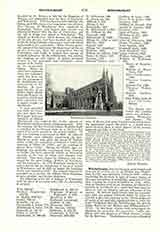

Wimborne (WIMBURN Or WINBURN) MINSTER, in Dorsetshire, England. Between the years 705-23 a double monastery like the famous house of St. Hilda at Whitby was founded at Wimborne by Sta. Cuthburga and Quimburga (feast August 31), sisters of Iile, King of the West Saxons (688-726). The discipline of Wimborne which followed the Benedictine Rule was especially severe in the matter of the nuns’ enclosure, into which not even prelates were allowed to enter. Under the Abbess St. Tetta there were a large number of nuns, among them St. Lioba, who was summoned to Germany by St. Boniface to govern the convent at Bischoffsheim, and her companion St. Thecla, afterwards Abbess of Kitzingen. The monastery was probably destroyed by raiding Danes in the ninth century: every trace of the Saxon buildings has vanished and even the site of St. Cuthburga’s Church is uncertain.
Secular canons were established at Wimborne either by King Edward the Confessor or one of his predecessors of the same name. The church was collegiate and a royal free chapel, and is so entered in Domesday Book. The list of the deans, who were of royal appointment, exists from 1224 to 1547. The establishment numbered 17 persons, a dean, 4 prebendaries, 3 vicars, 4 deacons, and 5 singing men. The deanery was in every case held in conjunction with some more important office. Reginald Pole was Dean of Wimborne from 1517 to 1537, being but 17 years of age on his appointment. In 1547 the college was suppressed. The minster is now the Anglican parish church. Its extreme length is 198 feet. The width, exclusive of the transepts, varies from 23 feet in the nave to 21 in the choir and presbytery. There is a western tower 95 feet in height, and another above the transepts (84 feet). The thirteenth-century spire which formerly crowned this latter tower fell in 1600. The present church is the result of gradual growth during the churchbuilding centuries up to the Reformation, without any of the great rebuilding operations such as took place in churches possessing popular shrines or great revenues. The church has suffered considerably at the hands of nineteenth-century restorers. It contains the beautiful altar-tomb of John Beaufort, Duke of Somerset, and Margaret his wife, the parents of the celebrated Lady Margaret, Foundress of Christ’s and St. John’s Colleges at Cambridge, and mother of King Henry VII. A small chained library dating from 1686 occupies a room over the vestry.
RAYMUND WEBSTER

